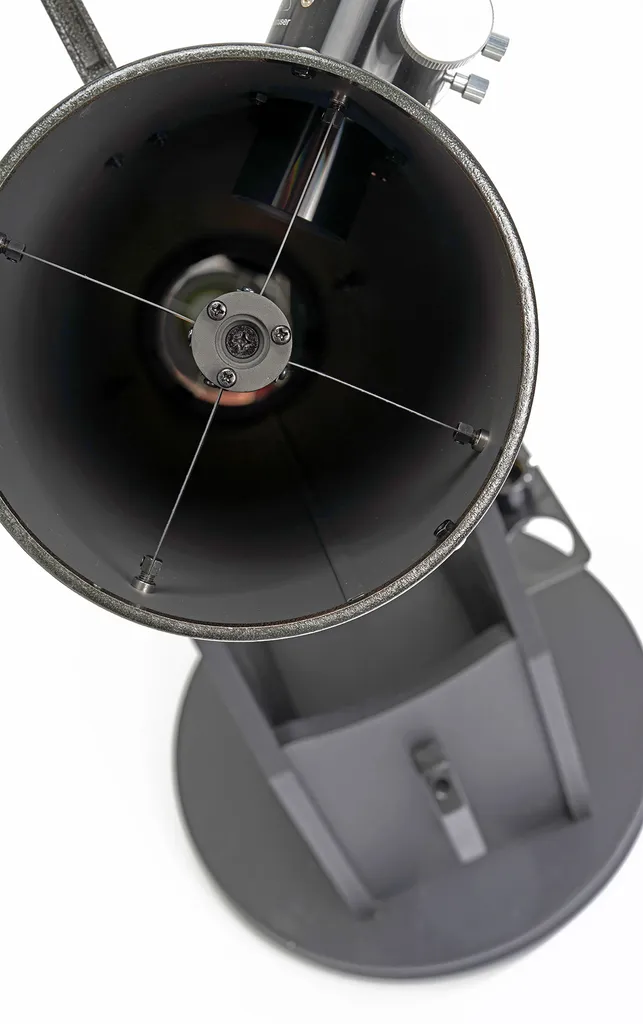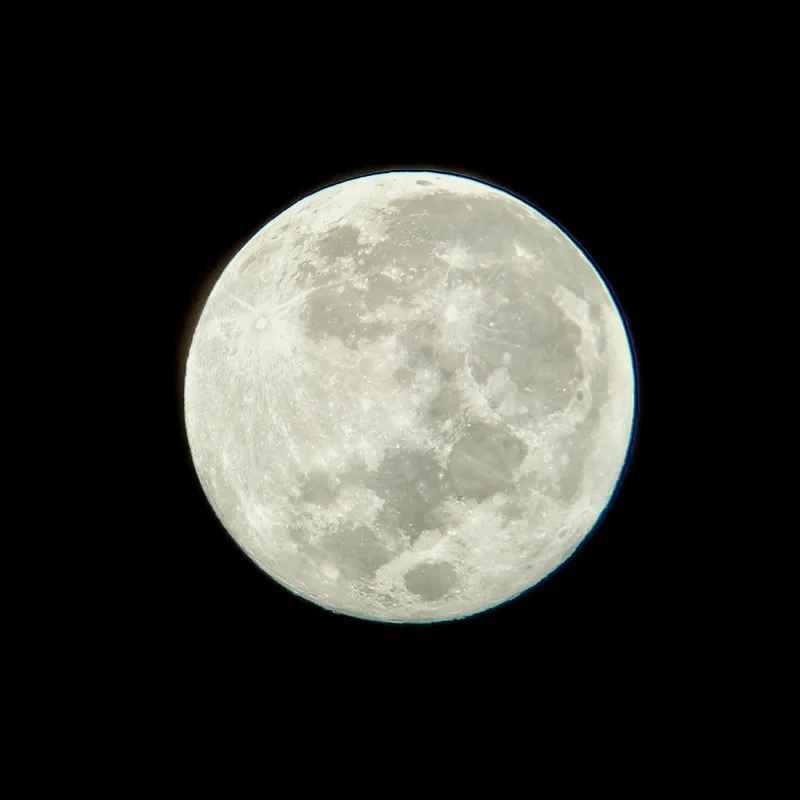The Ursa Major 6-inch f/8 telescope is part of a family of budget-friendly Dobsonians, ranging from 80mm to a substantial 8-inch.
This model is offered as a planetary option, thanks to its long focal length of 1,200mm.
We were keen to see whether the optical quality promised by the coated, high-reflectivity primary mirror (guaranteed at least 93% reflective) would support this.

Unboxing and setting up
The Ursa Major 6-inch Dobsonian arrived in two boxes, one for the optical tube assembly (OTA) and the other for the wooden mount, which was flat-packed and so required assembly.
The assembly instructions are on the First Light Optics website. We found them easy to follow and had it built within 30 minutes.
Inspecting the setup, the feel of the telescope is as we’d expect for a budget Newtonian.
We were impressed with the look of the focuser and the finderscope bracket, both of which exceeded expectations.
The mount and base were robust, although it took a few tweaks to get everything fitting together.
For example, the side panels needed a few adjustments for the OTA to cradle properly.
We also played about with the side bearing spring system. However, this fine-tuning didn’t take long.
A selection of accessories are supplied to get beginners started: two eyepieces, one a low-powered 25mm and the other a higher-magnification 9mm, both Plössl and 1.25-inch fit, along with a finderscope.
It’s best to carry the OTA and mount separately so we were careful not to put our eyepieces in the tray until outside. Under clear autumn skies, we examined collimation.
Popping the 25mm eyepiece in, we were pleased to note the Ursa Major arrived near-perfectly collimated – a rare yet brilliant discovery!
Collimation is one of the trickier aspects of a reflector and can prove quite a hurdle for beginners.
While we did do a minor collimation to put the optical system through its paces, the OTA could certainly be used without it.

How it performed
Looking at the bright star Vega with the Ursa Major 6-inch Dobsonian, we saw minimal colour fringing or diffraction spikes.
The stellar views were very good, although we did see some elongation of stars towards the edges of the field of view (FOV).
This isn’t surprising for a budget telescope, and certainly this 6-inch reflector gave excellent early impressions.
The movement of the focuser was fluid, even at its single speed. It still felt like we had a lot of focus control.
We then moved to a more stringent test of the resolving power, heading over to the Double Double, Epsilon Lyrae.
The mount was easy to move as we travelled between objects.
Inserting the higher-powered 9mm eyepiece, we resolved crisp and beautiful views of the four stars in the system.
We will highlight, however, that it is too easy to move the base from left to right, knocking the FOV once on an object.
This means extra care should be taken, which may prove tricky if viewing with young ones, who tend to grab eyepieces.
Having performed well in star tests, we took advantage of the dark night to take a look at M31, the Andromeda Galaxy.
We could easily see the very bright core and its satellite galaxies via the 25mm eyepiece.
As the Ursa Major 6-inch Dobsonian is a planetary telescope, however, it was time to head to Saturn.
Through the 9mm eyepiece the planet appeared crisp and clean, with a clear gap between the disc of the planet and its rings.
We had been pleasantly surprised with the optical capabilities of the Ursa Major 6-inch system, and several nights later we were back out to view a full supermoon.
While it was too bright to enjoy crater details, we could see that the 25mm eyepiece provided very little to no colour fringing.
Popping our smartphone carefully over it, we took a lovely photo of the Moon to document our session.
All in all, the Ursa Major outperforms many of its competitors in the same price bracket and should keep fledgling astronomers encouraged and engaged while they scope out their interest.

A beginners' telescope?
So is the Ursa Major 6-inch Dobsonian really a telescope for beginners?
The 6-inch aperture and 1,200mm focal length of this Newtonian are an excellent choice for a first telescope.
As a reflector, the 6-inch aperture collects enough light to provide pleasing views of a wide range of astronomical objects, while remaining compact enough to still be portable.
These attributes help to encourage newcomers to astronomy, as they won’t be limited to just observing the Moon: detailed and inspiring views of galaxies, star clusters and planets can also be enjoyed.
The Newtonian optical design also gives beginners access to higher magnifications, allowing close-up views of nebulae that would appear much smaller if using a refractor of a similar price.
This gives plenty of scope for users to enjoy this reflector even once they’ve become more experienced as visual astronomers.
Ursa Major has carefully considered the design of this 6-inch Dobsonian to ensure it is simple to collimate, with easily adjustable collimation knobs on the outside of the tube.
This makes a tricky technique straightforward for beginners and allows them to get the best optical experience from this budget reflector.

Best features
6x30mm finderscope
A finderscope is essential for finding your way around the night sky and Ursa Major’s Dobsonian comes ready with a mounting slot on the tube and a metal bracket to attach the straight-through finderscope. Tension screws enable you to adjust its position to suit.
1.25-inch Crayford focuser
The CNC-machined, single-speed focuser comes with two tension adjustment knobs to provide excellent focus control while being easy to use. These also ensure that the focus doesn’t slip if using heavier eyepieces. The diameter is suitable for a wide range of 1.25-inch eyepieces, Barlow lenses and other accessories.
Accessories tray
Swapping out eyepieces can be difficult if you’re having to rifle through a bag in pitch darkness. The easy-to-access eyepiece tray at the side of the mount makes changing between accessories easy, while limiting the risk of damaging or losing them.
Carry handle
Budding astronomers often want to transport their new telescope to dark-sky sites or local astronomy societies in order to get to know their kit. The carry handle, securely attached to the sturdy mount, allows it to be easily transported to different locations and to last-minute observing sessions when clear skies appear.
360° rotating Dobsonian mount
The wooden rotating base is well designed, with a roller-bearing assembly to aid sideways adjustments and metal plates sandwiched between the bases to keep action smooth throughout each session. Teflon pads allow you to gently alter the altitude of the OTA, and the spring tension system provides more resistance.
Key stats
- Price: £269
- Optics: Newtonian reflector, 152mm (6-inch) parabolic primary mirror
- Focal length: 1,200mm, f/7.9
- Mount: Dobsonian with spring tension control
- Extras: 1.25-inch 9mm and 25mm Plössl eyepieces, finderscope
- Weight: 23kg
- Supplier: First Light Optics
- Email: questions@firstlightoptics.com
- www.firstlightoptics.com
This review appeared in the December 2023 issue of BBC Sky at Night Magazine.
